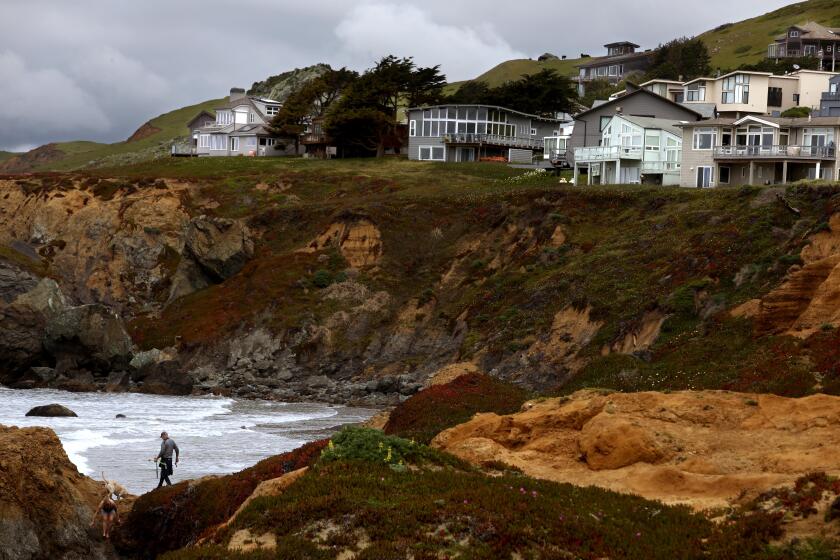Californian Finds Blustery Winds on Nantucket
Because I had never seen the island, the thought came to mind the night before: How about lighting a candle to the patron saint of good weather?
Maybe I didn’t have the saint’s full attention, for the next morning’s sky was gray and overcast. It was that melancholy season of fall colors, and summer’s sweet song had become an echo.
On the pier at Lewis Bay there weren’t that many people queuing up for the 2 1/2-hour ferry ride to the island. Those who were there were bundled in heavy slacks, thick sweaters and jackets. Wearing California clothes--shorts and surf shirts--I felt distinctly out of place. Didn’t they realize it’s just the end of summer?
It was warm enough on deck. Perhaps the sun would break through. But outside the breakwater of Hyannis Harbor the sky looked as sullen as ever, and angry whitecaps began to pound the boat. The wind blew fiercely. So the idea was to go below.
It’s warm on the inside lower deck--a kind of sanctuary. I gazed through the spray-dashed windows; the roll of the boat made me drowsy. I dozed.
As It Really Is
Later, Nantucket loomed ahead, its weather-scarred, shingled houses looking discouragingly in tune with the elements. I remembered pictures from the travel book--the spanking white facades under the deep blue skies. Don’t they ever show it the way it really is?
A hundred yards from the Nantucket pier are bike rental shops, and because the last boat leaves at 6:30 p.m., it seemed a good idea to explore the outer reaches of the island first. Siasconset, for example. Or “Sconset,” as the locals say.
The village lies six miles distant along a bike path that flanks the road. It’s an easy ride, straight as a whaler’s harpoon, and no hills.
Sconset was settled as a fishing village around 1675, making it among the oldest communities on the island. Two 17th-Century houses are there, and yet as one pedals through the shady streets of the village past well-kept lawns, one realizes that the old and the new have a way of blending--and that’s true of most of New England architecture. With their unchanging style, it’s difficult to know for sure when the houses were built: 30 years ago or 300.
Sconset appears to have defined the word quiet, and it’s understandable that actors and other professional people have used it as a retreat. A pocket-size post office and general store comprise the village center; an excellent French restaurant, the Chanticleer, is on a side street.
Taking the Long Way
A few miles north lies Sankaty Light; since 1849 it has warned ships of the dangerous shoals at this eastern end of Nantucket. I decided to pedal by it, then take the northerly and longer route back to Nantucket Town. Optimist. Then came the first drops of rain.
It was raining harder by the time the lighthouse appeared, some distance down a dirt road. I decided not to try it. I took the Polpis Road, skirting the settlements of Quidnet, Polpis and others. The wind was strong now. And this part of the island is hillier. Why do all the hills have more ups than downs? The idea is to pedal faster, but the rain was pouring harder.
It was 3 o’clock when Nantucket Town came into focus; the bike was rebeling at the uneven cobblestone streets. Later, the rain stopped, fortunately, and the town was small enough to explore on foot. But it was cold--California clothes weren’t made for this Eastern weather. Besides that, I was hungry.
Strawberry Sundae
I stopped at an old-fashioned ice cream parlor and, perhaps because the place looked like something straight out of Thornton Wilder’s “Our Town,” I developed an inexplicable craving for a strawberry ice cream sundae with all the trappings. That and plenty of hot coffee. After starting with a bowl of steaming clam chowder, of course.
As the center of the whaling industry, Nantucket was once the third-richest seaport in Massachusetts. Sea captains of the 18th and 19th centuries spent part of their profits in building elegant mansions that line its tree-shrouded streets. Those clustered along Main Street are a short walk from the town center. “The Three Bricks” dominate: They’re identical mansions, side by side, built by whaling merchant Joseph Starbuck for his three sons in 1836-38. One of the mansions is still in the family.
By the time I reached the street’s end, a fair amount of Nantucket history had appeared. Then I heard the rain again, most of it, it seemed, lingering in the thick leaves of the trees. The old houses, indomitable against all elements, took on an aura of quiet resignation; they could not have looked any different to the whaling captains returning after their long voyages. And with the heavy trees, the sun probably never reached them much anyway.
Hard Times
What better time to visit a museum than in the rain? The Whaling Museum, housed in what was originally a factory to refine spermaceti, chronicles the history of Nantucket’s glory days. Next door the Peter Foulger Museum provides a more general history of the island, for when the whaling industry got shunted aside in the oil discoveries of the post-Civil War period, Nantucket fell on hard times.
Population dwindled to a third of what it had been in 1840, and it wasn’t until the end of the 19th Century, when the beneficiaries of the Industrial Revolution looked for ways to spend their money, that the summer folk, and finally the tourists, began to rediscover Nantucket.
Well, they found it all right, you tell yourself, having nudged shoulders with the many visitors who had also sought refuge in the museums. But at least I was drier than I had been in several hours.
Outside, and headed toward the ice cream parlor again, it was time to take a close look at those few struggling tourists. They were a more muted group than I was used to, with many college-age kids along with middle-class families. They all seemed to demonstrate considerable respect for what they found: shops and restaurants that upheld a sense of the past, the refreshing absence of fast-food chains and shopping malls, bookstores well stocked with hard-to-get titles. Nantucket is surviving the 20th Century with hardly a ripple.
Seated in front of another spirit-bolstering bowl of chowder, the rain started up again, beating a steady rhythm on the cobblestones. It was a comforting sound; let the sky be as dark as it wants. It all fit, it all seemed right somehow--perhaps I was seeing Nantucket as it wants to be seen. After all, they do call it “the gray lady.”
And later, aboard the ferry headed back toward Hyannis, I wondered about that patron saint. Maybe he was listening all the while.
For more information on traveling in Massachusetts, contact the Massachusetts Department of Commerce and Development, Division of Tourism, 100 Cambridge St., 13th Floor, Boston 02202, phone (617) 727-3201.
Sign up for The Wild
We’ll help you find the best places to hike, bike and run, as well as the perfect silent spots for meditation and yoga.
You may occasionally receive promotional content from the Los Angeles Times.



